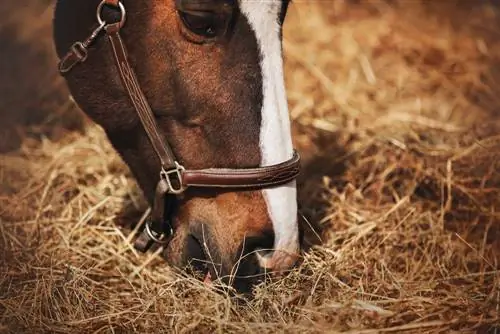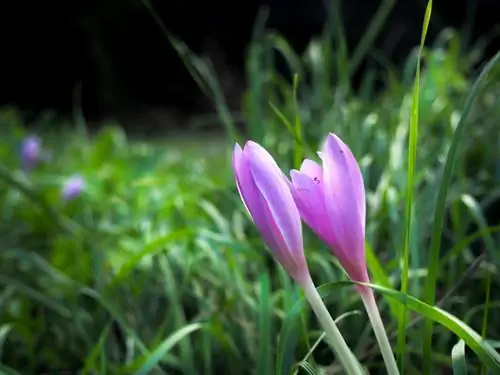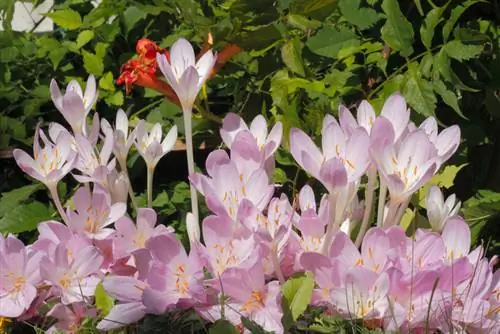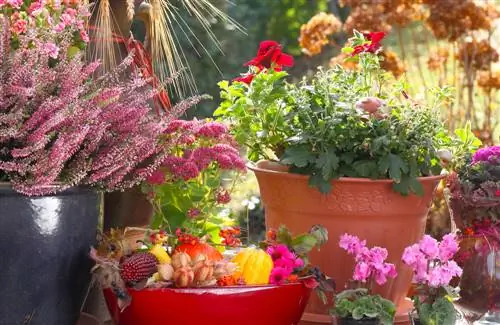- Author admin [email protected].
- Public 2023-12-16 16:46.
- Last modified 2025-06-01 06:02.
Autumn crocus in the hay sets alarm sirens ringing for animal owners. For good reason, there is a clear zero tolerance limit for the poisonous plant in canned food. You are not completely helpless against the deadly poisonous attacks. This is what to do if autumn crocus contaminates the hay.
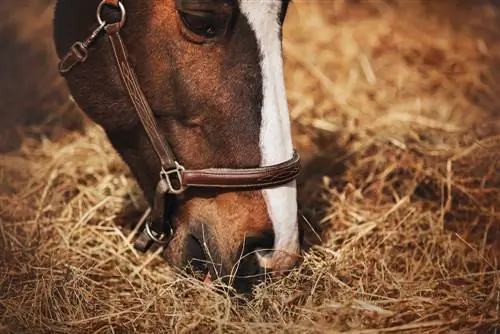
What should you do if autumn crocus contaminates the hay?
If autumn crocus is discovered in hay, you should immediately dispose of the contaminated hay, combat the poisonous plant in hay meadows and pastures and take effective preventive measures to prevent future infestations.
Autumn crocus in the hay - what to do?
The autumn crocus (Colchicum autumnale) is very poisonous to many large and small animalsAll parts of the plant contain 20 toxic alkaloids, including a high concentration of the cell toxin colchicine. Horses, cows, sheep, rabbits, hamsters and other animals that feed on hay are at great risk. Unfortunately, the poisonous plant in hay is often not discovered or is discovered too late. Fatal poisonings are the result. It doesn't have to come to that. What to do:
- Dispose of hay contaminated with autumn crocus.
- Fighting autumn crocuses on hay meadows and pastures.
- Effectively prevent autumn crocus infestation.
Can I sort out autumn crocuses in the hay?
When dried, the autumn crocus remains a deadly poisonous plant. Since the toxic seeds stick strongly, you cannot sort out the poisonous plant from the contaminated hayConsuming small amounts of autumn crocus in hay can have life-threatening consequences for stable animals. The acute lethal dose for a horse is 1 mg/kg body weight. This corresponds to 400 grams of dried autumn crocus. If the horse repeatedly consumes a small amount, muscle loss and severe liver damage occur.
How can I control autumn crocus in pastures?
The primary goal of combating autumn crocuses on mowed and grazing areas is to push back the poisonous plant bystarvation. To ensure that autumn crocus does not contaminate the hay for your animals, these effective control methods have proven to be excellent in practice:
- In April and May, cut out the tubersas soon as the characteristic, threefold autumn crocus leaves appear.
- From August, cut out individual flowering autumn crocuses, mow the affected area to a depth of 3 cm, and reseed gaps as soon as possible.
- Important: Don’t forget gloves for your own protection.
How can I prevent autumn crocus in the hay?
Preventative measures ensure that you don't have to deal with autumn crocus in the hay. To prevent the poisonous plant from establishing itself on pastures or hay meadows, we recommend these preventive measures:
- Regular mulching to prevent incoming autumn crocus seeds from germinating.
- Repeated towing or currying of the green area followed by reseeding for a dense, firm turf.
- Need-based fertilization and liming in coordination with soil conditions, management and local conditions.
Tip
Autumn crocus - the deadly poisonous wild garlic lookalike
Casu alties continue to occur because people confuse the poisonous autumn crocus with tasty wild garlic plants. In spring 2021, a 48-year-old man in Bavaria lost his life because the supposed wild garlic sauce consisted of autumn crocus. In view of the risk of fatal confusion, doctors strongly advise against collecting wild garlic in the forest. Home-grown wild garlic, on the other hand, promises carefree herbal enjoyment.

